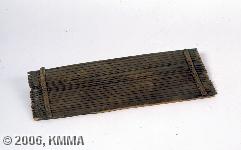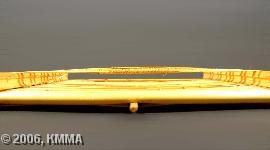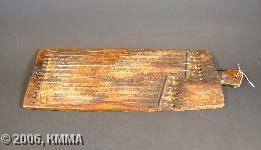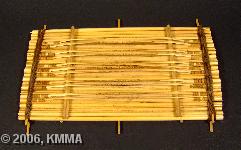



An important zither type is represented in the Congo by the board zither, which, together with the trough zither, is closely related to zither types from the South-East Asian musical cultures. The board zither is distributed throughout the north-east and the southern part of the Congo. The board zither consists of a flat fretboard (a plank) over which strings are stretched and held in place with grooves and two bridges on each narrow end of the board. The number of grooves varies between 3 and 20 but is generally around 13. Through these grooves one long string runs up and down and across the fretboard and through the bridges, thus producing several short strings. In order to obtain the desired pitch for each string the musician tunes by sliding the strings over the bridges. A tighter string produces a higher pitch, but by moving it, the tension in the following string can be decreased, lowering its pitch. This string must also be tightened therefore as a result of the shift in tension. This process must be repeated for each string section down to the very last one, which generally is not played and therefore does not in fact require tuning. Board zithers frequently possess more strings than are in fact played. The strings are generally made from natural or animal material, but in the last few decades metal strings have become more popular.
In order to make the strings easier to play, smaller bridges are inserted under both sides. The bridge is a thin slat with a flat, semi-circular or round section. Sometimes there is a third, higher bridge, which is inserted nearer to the middle of the strings, although it is not necessary in order to play the instrument, but can increase the tension, which enhances the playing volume. It also ensures that each string can be individually tuned without influencing the pitch of the other strings.
To obtain more volume a sound box is attached to the fretboard. This can be either a traditional hollow calabash or (less obviously) a supple piece of bark around the base and sides of the fretboard.
The strings of the board zither are either plucked with the fingers or struck with a stick. A unique playing method consists of shortening some of the strings by pressing them with the finger tips against the fretboard and striking a chord with the other hand in an arpeggio style.
The board zither is generally played by men, in some tribes exclusively so, and serves as an accompaniment to singing, dance or magic rituals, or for relaxation. In addition the board zither is played for deceased ancestors and in the context of hunting rituals, to favourably influence protective spirits.
This type of instrument is used in recordings of our sound archives made with the Congolese peoples mentioned hereafter where it appears with the following vernacular names:
Bafili (Bali, Kumu), Bapili (Mbuti), Enanga (Nande), Enzenze (Nande), Esanzo (Mongo), Inanga (Lega, Rundi), Inanga (Kinubi) (Hutu), Kingwandikila (Bembe), Langangu (Mbunda), Lulanga (Shi), Lunzenze (Luba-Kasai), Mafili (Bafili) (Pygmées), Nanga (Banyoro), Nedongu (Mangbetu), Ngombi (Segwirunibia) (Zande), Ngyela (Luba), Nzenze (Bira), Nzenze (zeze) (Lega), Seki (Mombutu), Zeze (Tembo)
Bibliography:
Discography:
© KMMA